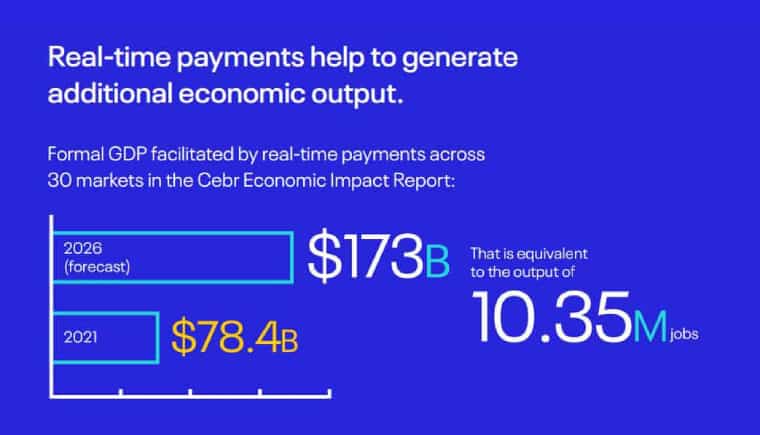The title of our yearly report exploring the growth and impact of real-time payments – Prime Time for Real-Time – is more apt than ever.
Why? Because market forces and global events have combined to develop significant momentum around real-time payments, placing the organizations that enable them right at the heart of modern economies.
The numbers speak for themselves
118.3 billion real-time transactions were made globally in 2021, forecast to grow to 427.7 billion annually in 2026. At this rate of growth, real-time payments would account for 25.6 percent of all global electronic payments in the next five years.
Meanwhile, research from our partners at the Centre for Economics and Business Research (Cebr), and included in Prime Time for Real-Time for the first time, shows a clear correlation between real-time payments and economic growth.
Real-time payments helped generate an additional economic output of $78.4 billion in 2021 across the 30 countries included in the Cebr study. By 2026, this figure is set to rise to $173 billion across the same group of countries, illustrating the scale of the opportunities, both already realized and untapped.

The evidence is clear: real-time payments boost economic growth
By allowing for the transfer of money between parties within seconds rather than days, real-time payments improve overall market efficiencies, unlocking economic growth.
However, the analysis barely hints at the story’s significance underlying much of this growth. An important driver of real-time payments adoption in recent years has been a series of unprecedented transformations to the daily lives of consumers and businesses. The transition to digital and real-time living, working and paying was already underway, but 2020 saw the COVID-19 pandemic accelerate adoption to new levels and there is no looking back.
Real-time payments offer consumers and businesses cheaper, faster and more efficient ways to pay. Payments are increasingly becoming embedded into non-financial digital apps and services, with consumers looking for a hyper-connected, frictionless customer experience.
Our new report reveals how modern economies depend on real-time payments to boost economic growth, prosperity and financial inclusion, with governments worldwide as the primary enabler of these systems. Yet, in the coming years, shaping the future of payments will come down to the individual financial institutions that take advantage of the opportunities enabled by these new payment rails.
Financial institutions globally are at different stages in their modernization journey. Some are contemplating, others are planning, but many more are reinventing their mission-critical operating systems to compete in the new real-time, post-digital, cloud-first and data-centric business environment. Inaction is not an option as broad-based disruption of the sector has moved beyond a tipping point.
In partnership with GlobalData and Cebr, we are excited to present an unprecedented view of the economic benefits stimulated by real-time payments, and how they are evolving globally.
Payment leaders will benefit from vital insights into where growth is likely to come, the speed with which it will arrive, and the payments modernization required to capitalize on it. It is a privilege to share our learnings and reflections in Prime Time for Real-Time for the third consecutive year.



